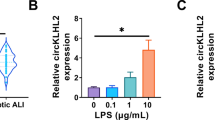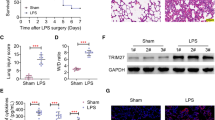Abstract
Background
The AU-rich element (ARE)-binding factor 1 (AUF1) acts as a switch for septic shock, although its underlying mechanisms remain largely unknown. In this study, we examined the biological significance and potential molecular mechanism of AUF1 in regulating ferroptosis in sepsis-induced acute lung injury (ALI).
Methods
Alveolar epithelial cells (AECs) challenged with ferroptosis-inducing compounds and cecum ligation and puncture (CLP)-induced ALI were used as the in vitro and in vivo model, respectively. The stability of AUF1 and its degradation by ubiquitin–proteasome pathway were examined by cycloheximide chase analysis and co-immunoprecipitation assay. The regulation of AUF1 on nuclear factor E2-related factor 2 (NRF2) and activation transcription factor 3 (ATF3) was explored by RNA immunoprecipitation (RIP), RNA pull-down, and mRNA stability assays. Functionally, the effects of altering AUF1, NRF2 or ATF3 on ferroptosis in AECs or ALI mice were evaluated by measuring cell viability, lipid peroxidation, iron accumulation, and total glutathione level.
Results
AUF1 was down-regulated in AECs challenged with ferroptosis-inducing compounds, both on mRNA and protein levels. The E3 ubiquitin ligase FBXW7 was responsible for protein degradation of AUF1 during ferroptosis. By up-regulating NRF2 and down-regulating ATF3, AUF1 antagonized ferroptosis in AECs in vitro. In the CLP-induced ALI model, the survival rate of AUF1 knockout mice was significantly reduced and the lung injuries were aggravated, which were related to the enhancement of lung ferroptosis.
Conclusions
FBXW7 mediates the ubiquitination and degradation of AUF1 in ferroptosis. AUF1 antagonizes ferroptosis by regulating NRF2 and ATF3 oppositely. Activating AUF1 pathway may be beneficial to the treatment of sepsis-induced ALI.








Similar content being viewed by others
Availability of data and materials
All data generated or analyzed during this study are included in this published article.
References
Vincent JL, Zambon M (2006) Why do patients who have acute lung injury/acute respiratory distress syndrome die from multiple organ dysfunction syndrome? Implications for management. Clin Chest Med 27:725–731. https://doi.org/10.1016/j.ccm.2006.06.010
Johnson ER, Matthay MA (2010) Acute lung injury: epidemiology, pathogenesis, and treatment. J Aerosol Med Pulm Drug Deliv 23:243–252. https://doi.org/10.1089/jamp.2009.0775
Mokra D, Kosutova P (2015) Biomarkers in acute lung injury. Respir Physiol Neurobiol 209:52–58. https://doi.org/10.1016/j.resp.2014.10.006
Li X, Zhuang X, Qiao T (2019) Role of ferroptosis in the process of acute radiation-induced lung injury in mice. Biochem Biophys Res Commun 519:240–245. https://doi.org/10.1016/j.bbrc.2019.08.165
Li Y et al (2020) Inhibitor of apoptosis-stimulating protein of p53 inhibits ferroptosis and alleviates intestinal ischemia/reperfusion-induced acute lung injury. Cell Death Differ. https://doi.org/10.1038/s41418-020-0528-x
Liu P et al (2020) Ferrostatin-1 alleviates lipopolysaccharide-induced acute lung injury via inhibiting ferroptosis. Cell Mol Biol Lett 25:10. https://doi.org/10.1186/s11658-020-00205-0
Zhou H et al (2019) Ferroptosis was involved in the oleic acid-induced acute lung injury in mice. Sheng Li Xue Bao 71:689–697
Li J et al (2020) Ferroptosis: past, present and future. Cell Death Dis 11:88. https://doi.org/10.1038/s41419-020-2298-2
Xie Y et al (2016) Ferroptosis: process and function. Cell Death Differ 23:369–379. https://doi.org/10.1038/cdd.2015.158
Wang L et al (2020) ATF3 promotes erastin-induced ferroptosis by suppressing system Xc(). Cell Death Differ 27:662–675. https://doi.org/10.1038/s41418-019-0380-z
Lu JY, Sadri N, Schneider RJ (2006) Endotoxic shock in AUF1 knockout mice mediated by failure to degrade proinflammatory cytokine mRNAs. Genes Dev 20:3174–3184. https://doi.org/10.1101/gad.1467606
Pan YX, Chen H, Kilberg MS (2005) Interaction of RNA-binding proteins HuR and AUF1 with the human ATF3 mRNA 3’-untranslated region regulates its amino acid limitation-induced stabilization. J Biol Chem 280:34609–34616. https://doi.org/10.1074/jbc.M507802200
Poganik JR et al (2019) Post-transcriptional regulation of Nrf2-mRNA by the mRNA-binding proteins HuR and AUF1. FASEB J 33:14636–14652. https://doi.org/10.1096/fj.201901930R
Martinez AM, Kim A, Yang WS (2020) Detection of Ferroptosis by BODIPY 581/591 C11. Methods Mol Biol 2108:125–130. https://doi.org/10.1007/978-1-0716-0247-8_11
Rittirsch D, Huber-Lang MS, Flierl MA, Ward PA (2009) Immunodesign of experimental sepsis by cecal ligation and puncture. Nat Protoc 4:31–36. https://doi.org/10.1038/nprot.2008.214
Li XH et al (2013) Protective effects of polydatin on septic lung injury in mice via upregulation of HO-1. Mediators Inflamm 2013:354087. https://doi.org/10.1155/2013/354087
Han H, Ziegler SF (2013) Bronchoalveolar lavage and lung tissue digestion. Bio Protoc. https://doi.org/10.21769/bioprotoc.859
Laroia G, Cuesta R, Brewer G, Schneider RJ (1999) Control of mRNA decay by heat shock-ubiquitin-proteasome pathway. Science 284:499–502. https://doi.org/10.1126/science.284.5413.499
Fan BY et al (2021) Liproxstatin-1 is an effective inhibitor of oligodendrocyte ferroptosis induced by inhibition of glutathione peroxidase 4. Neural Regen Res 16:561–566. https://doi.org/10.4103/1673-5374.293157
Miotto G et al (2020) Insight into the mechanism of ferroptosis inhibition by ferrostatin-1. Redox Biol 28:101328. https://doi.org/10.1016/j.redox.2019.101328
Dodson M, Castro-Portuguez R, Zhang DD (2019) NRF2 plays a critical role in mitigating lipid peroxidation and ferroptosis. Redox Biol 23:101107. https://doi.org/10.1016/j.redox.2019.101107
Zhu H, Santo A, Jia Z, Robert Li Y (2019) GPx4 in bacterial infection and polymicrobial sepsis: involvement of ferroptosis and pyroptosis. React Oxyg Species (Apex) 7:154–160. https://doi.org/10.20455/ros.2019.835
Tang PS, Mura M, Seth R, Liu M (2008) Acute lung injury and cell death: how many ways can cells die? Am J Physiol Lung Cell Mol Physiol 294:L632-641. https://doi.org/10.1152/ajplung.00262.2007
Lei P, Bai T, Sun Y (2019) Mechanisms of ferroptosis and relations with regulated cell death: a review. Front Physiol 10:139. https://doi.org/10.3389/fphys.2019.00139
Dixon SJ et al (2012) Ferroptosis: an iron-dependent form of nonapoptotic cell death. Cell 149:1060–1072. https://doi.org/10.1016/j.cell.2012.03.042
Friedmann Angeli JP, Krysko DV, Conrad M (2019) Ferroptosis at the crossroads of cancer-acquired drug resistance and immune evasion. Nat Rev Cancer 19:405–414. https://doi.org/10.1038/s41568-019-0149-1
Hassannia B, Vandenabeele P, Vanden Berghe T (2019) Targeting Ferroptosis to Iron Out Cancer. Cancer Cell 35:830–849. https://doi.org/10.1016/j.ccell.2019.04.002
Mou Y et al (2019) Ferroptosis, a new form of cell death: opportunities and challenges in cancer. J Hematol Oncol 12:34. https://doi.org/10.1186/s13045-019-0720-y
Friedmann Angeli JP et al (2014) Inactivation of the ferroptosis regulator Gpx4 triggers acute renal failure in mice. Nat Cell Biol 16:1180–1191. https://doi.org/10.1038/ncb3064
Linkermann A et al (2014) Synchronized renal tubular cell death involves ferroptosis. Proc Natl Acad Sci U S A 111:16836–16841. https://doi.org/10.1073/pnas.1415518111
Muller T et al (2017) Necroptosis and ferroptosis are alternative cell death pathways that operate in acute kidney failure. Cell Mol Life Sci 74:3631–3645. https://doi.org/10.1007/s00018-017-2547-4
Chen X, Xu S, Zhao C, Liu B (2019) Role of TLR4/NADPH oxidase 4 pathway in promoting cell death through autophagy and ferroptosis during heart failure. Biochem Biophys Res Commun 516:37–43. https://doi.org/10.1016/j.bbrc.2019.06.015
Liu B et al (2018) Puerarin protects against heart failure induced by pressure overload through mitigation of ferroptosis. Biochem Biophys Res Commun 497:233–240. https://doi.org/10.1016/j.bbrc.2018.02.061
Rossaint J, Zarbock A (2015) Pathogenesis of multiple organ failure in sepsis. Crit Rev Immunol 35:277–291. https://doi.org/10.1615/critrevimmunol.2015015461
Kang R et al (2018) Lipid peroxidation drives gasdermin D-mediated pyroptosis in lethal polymicrobial sepsis. Cell Host Microbe 24:97-108.e104. https://doi.org/10.1016/j.chom.2018.05.009
Wang C et al (2020) Dexmedetomidine alleviated sepsisinduced myocardial ferroptosis and septic heart injury. Mol Med Rep 22:175–184. https://doi.org/10.3892/mmr.2020.11114
Oh BM et al (2019) Erastin inhibits septic shock and inflammatory gene expression via suppression of the NF-kappaB pathway. J Clin Med. https://doi.org/10.3390/jcm8122210
Xu M et al (2020) Ferroptosis involves in intestinal epithelial cell death in ulcerative colitis. Cell Death Dis 11:86. https://doi.org/10.1038/s41419-020-2299-1
Moore AE, Chenette DM, Larkin LC, Schneider RJ (2014) Physiological networks and disease functions of RNA-binding protein AUF1. Wiley Interdiscip Rev RNA 5:549–564. https://doi.org/10.1002/wrna.1230
Barker A et al (2012) Sequence requirements for RNA binding by HuR and AUF1. J Biochem 151:423–437. https://doi.org/10.1093/jb/mvs010
Lal A et al (2004) Concurrent versus individual binding of HuR and AUF1 to common labile target mRNAs. EMBO J 23:3092–3102. https://doi.org/10.1038/sj.emboj.7600305
Trojanowicz B, Dralle H, Hoang-Vu C (2011) AUF1 and HuR: possible implications of mRNA stability in thyroid function and disorders. Thyroid Res. https://doi.org/10.1186/1756-6614-4-S1-S5
Zhang Z et al (2019) RNA-binding protein ZFP36/TTP protects against ferroptosis by regulating autophagy signaling pathway in hepatic stellate cells. Autophagy. https://doi.org/10.1080/15548627.2019.1687985
Kerins MJ, Ooi A (2018) The Roles of NRF2 in Modulating Cellular Iron Homeostasis. Antioxid Redox Signal 29:1756–1773. https://doi.org/10.1089/ars.2017.7176
Abdalkader M, Lampinen R, Kanninen KM, Malm TM, Liddell JR (2018) Targeting Nrf2 to Suppress Ferroptosis and Mitochondrial Dysfunction in Neurodegeneration. Front Neurosci 12:466. https://doi.org/10.3389/fnins.2018.00466
Huang HX et al (2020) TFAP2A is a novel regulator that modulates ferroptosis in gallbladder carcinoma cells via the Nrf2 signalling axis. Eur Rev Med Pharmacol Sci 24:4745–4755. https://doi.org/10.26355/eurrev_202005_21163
Liu Q, Wang K (2019) The induction of ferroptosis by impairing STAT3/Nrf2/GPx4 signaling enhances the sensitivity of osteosarcoma cells to cisplatin. Cell Biol Int 43:1245–1256. https://doi.org/10.1002/cbin.11121
Roh JL, Kim EH, Jang H, Shin D (2017) Nrf2 inhibition reverses the resistance of cisplatin-resistant head and neck cancer cells to artesunate-induced ferroptosis. Redox Biol 11:254–262. https://doi.org/10.1016/j.redox.2016.12.010
Song X, Long D (2020) Nrf2 and ferroptosis: a new research direction for neurodegenerative diseases. Front Neurosci 14:267. https://doi.org/10.3389/fnins.2020.00267
Shin CS et al (2017) The glutamate/cystine xCT antiporter antagonizes glutamine metabolism and reduces nutrient flexibility. Nat Commun 8:15074. https://doi.org/10.1038/ncomms15074
Acknowledgements
We would like to give our sincere gratitude to the reviewers for their constructive comments.
Funding
This work was supported by National Natural Science Foundation of China (No.31872800), Foundation of The Third Affiliated Hospital of Guangzhou Medical University (No.2019Z02) and Foundation of Guangzhou Science and Technology Burea (No.202102010089).
Author information
Authors and Affiliations
Contributions
Guarantor of integrity of the entire study: CD, WYC. Study concepts: WYC, TDL. Study design: WYC, TDL, SXF. Definition of intellectual content: WYC, SXF. Literature research: XH, GFF, PF. Experimental studies: GFF, WYC, CDY. Data acquisition: JMW, GFF. Data analysis: XH, SXF. Statistical analysis: JMW, XH. Manuscript preparation: XH, CDY. Manuscript editing: SXF. Manuscript review: WYC, TDL. All authors read and approved the final manuscript.
Corresponding authors
Ethics declarations
Ethical approval
All animal protocols were reviewed and approved by the Institutional Animal Care and Use Committee of Guangzhou Medical University (Guangzhou, Guangdong, China).
Informed consent
The informed consent obtained from study participants.
Conflict of interest
The authors declare that they have no conflict of interest.
Additional information
Publisher's Note
Springer Nature remains neutral with regard to jurisdictional claims in published maps and institutional affiliations.
Supplementary Information
Below is the link to the electronic supplementary material.
18_2022_4248_MOESM1_ESM.tif
Supplementary file 1. Fig. S1. Liproxstatin-1 antagonizes the pro-ferroptotic effects of shNRF2. shNRF2 and control shRNA (shNC) lentiviruses were transduced into AECs for 48 h, before the cells were treated with Lirpoxstatin-1 (inhibitor of ferroptosis, 25 nM) for 12 h. Ferroptosis was assessed by measuring cell viability using MTT assay (A), intracellular iron (B), BODIPY staining (C), and total glutathione (D) levels in indicated cells. *P < 0.05, **P < 0.01 and ***P < 0.001.
Rights and permissions
About this article
Cite this article
Wang, Y., Chen, D., Xie, H. et al. AUF1 protects against ferroptosis to alleviate sepsis-induced acute lung injury by regulating NRF2 and ATF3. Cell. Mol. Life Sci. 79, 228 (2022). https://doi.org/10.1007/s00018-022-04248-8
Received:
Revised:
Accepted:
Published:
DOI: https://doi.org/10.1007/s00018-022-04248-8




